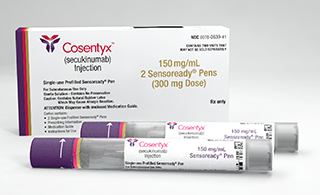Amid tough competition, Novartis makes case for rheumatology drug Cosentyx

It’s two years since Novartis got its Cosentyx IL-17 drug approved for the spinal disease ankylosing spondylitis, and the Swiss pharma company has new data that it hopes will allow it to compete more strongly with older drugs such as AbbVie’s Humira in this surprisingly common illness.
In an interview with pharmaphorum Eric Hughes, global development franchise head at Novartis, for immunology, hepatology and dermatology, said the company will present new data at this week’s European League Against Rheumatism (EULAR) conference that will make the case for Cosentyx (secukinumab) in a highly competitive market.
Cosentyx is a key drug for Novartis, as it is part of the company’s plan to replace lost sales from off-patent cancer drug Gleevec.
But earlier this year the company had a nasty surprise when quarter-on-quarter revenues fell from $615 million in Q4 2017 to $580 million in Q1 2018.
Ankylosing spondylitis (AS) is a condition where the joints in the spine become inflamed because of over-activity in the immune system, causing pain and reducing flexibility. The individual bones of the spine may fuse as the disease progresses, and this can be detected using X-rays.
Including Cosentyx there are six FDA-approved drugs for ankylosing spondylitis, including AbbVie’s mega-blockbuster Humira (adalimumab), Johnson & Johnson/MSD’s Remicade (infliximab), and Amgen/Pfizer’s Enbrel (etanercept).
There are also cheaper biosimilar near-copies of these older drugs approved in certain markets, meaning Cosentyx is not just competing on the basis of efficacy, but also on price.
Novartis has data from the MEASURE 1 study, showing almost 80% of AS patients have no radiographic progression of the spine at four years.
There is also data from MEASURE 2 showing Cosentyx provides sustained improvement in signs and symptoms of AS for up to four years, and did so with a “consistent and favourable” safety profile.
Added to this there was a glowing 90% approval rate among patients from a separate quality of life study, with 74% saying that they preferred Cosentyx to previous treatments.
Hughes said: “We have been able to show a great response, and that this lasts for a long time.”
Novartis has now begun a study that will answer the question about whether Cosentyx is better than Humira in AS – although the trial will involve a biosimilar of Humira developed by Novartis’ own Sandoz unit.
Hughes told pharmaphorum: “We are so confident in this drug that we have already initiated a head-to-head study between Cosentyx and adalimumab. It is the biggest study running in AS.”
Results of the superiority study will be ready in around two years’ time, said Hughes.
Novartis is also testing Cosentyx in a precursor to AS in the PREVENT study. Many patients with a disease known as non-radiographic axial spondyloarthritis go on to develop AS and Novartis hopes to show that targeting IL-17 with Cosentyx can slow or prevent this.
Enrolment on the trial is just finishing, and could lead to a further indication for Cosentyx, on top of AS, psoriatic arthritis and plaque psoriasis.
Hughes added that disease awareness is important for Novartis, as AS affects around 1% of the world wide population and is often misdiagnosed as back pain. “It is something we can really treat, it is something we can really improve for patients,” he said.
Novartis will also present data from Cosentyx in psoriatic arthritis at EULAR, showing it inhibits progression of psoriatic arthritis (PsA) out to Week 24 of treatment.












